Studies on Annihilation and Coreactant Electrochemiluminescence of Thermally Activated Delayed Fluorescent Molecules in Organic Medium
Abstract
1. Introduction
2. Experimental
2.1. TADF Luminophores
2.2. Measurements of Photophysics
2.3. Cyclic Voltammetry (CV) and ECL Measurements
3. Results and Discussion
3.1. Photophysical Properties of TADF Luminophores in DCM
3.2. Electrochemistry
3.3. Annihilation and Coreactant TADF-ECL
3.4. ECL Spectra and Mechanisms of Coreactant TADF-ECL
4. Conclusions
Supplementary Materials
Author Contributions
Funding
Institutional Review Board Statement
Informed Consent Statement
Data Availability Statement
Acknowledgments
Conflicts of Interest
Sample Availability
References
- Kanoufi, F.; Sojic, N. Single reaction events imaged in total darkness. Nature 2021, 596, 194–195. [Google Scholar] [CrossRef] [PubMed]
- Dong, J.R.; Lu, Y.X.; Xu, Y.; Chen, F.F.; Yang, J.M.; Chen, Y.; Feng, J.D. Direct imaging of single-molecule electrochemical reactions in solution. Nature 2021, 596, 244–249. [Google Scholar] [CrossRef]
- Xiong, H.; Huang, Z.; Lin, Q.; Yang, B.; Yan, F.; Liu, B.; Chen, H.; Kong, J. Surface Plasmon Coupling Electrochemiluminescence Immunosensor Based on Polymer Dots and AuNPs for Ultrasensitive Detection of Pancreatic Cancer Exosomes. Anal. Chem. 2022, 94, 837–846. [Google Scholar] [CrossRef] [PubMed]
- Wu, Y.F.; Jamali, S.; Tilley, R.D.; Gooding, J.J. Spiers Memorial Lecture. Next generation nanoelectrochemistry: The fundamental advances needed for applications. Faraday Discuss. 2022, 233, 10–32. [Google Scholar] [CrossRef] [PubMed]
- Liu, Y.; Zhang, H.; Li, B.; Liu, J.; Jiang, D.; Liu, B.; Sojic, N. Single Biomolecule Imaging by Electrochemiluminescence. J. Am. Chem. Soc. 2021, 143, 17910–17914. [Google Scholar] [CrossRef]
- Du, F.X.; Chen, Y.Q.; Meng, C.D.; Lou, B.H.; Zhang, W.; Xu, G.B. Recent advances in electrochemiluminescence immunoassay based on multiple-signal strategy. Curr. Opin. Electrochem. 2021, 28, 100725. [Google Scholar] [CrossRef]
- Chen, M.M.; Xu, C.H.; Zhao, W.; Chen, H.Y.; Xu, J.J. Super-Resolution Electrogenerated Chemiluminescence Microscopy for Single-Nanocatalyst Imaging. J. Am. Chem. Soc. 2021, 143, 18511–18518. [Google Scholar] [CrossRef]
- Wang, Z.; Guo, H.; Luo, Z.; Duan, Y.; Feng, Y. Low-Triggering-Potential Electrochemiluminescence from a Luminol Analogue Functionalized Semiconducting Polymer Dots for Imaging Detection of Blood Glucose. Anal. Chem. 2022, 94, 5615–5623. [Google Scholar] [CrossRef]
- Zhou, X.; Zhu, D.; Liao, Y.; Liu, W.; Liu, H.; Ma, Z.; Xing, D. Synthesis, labeling and bioanalytical applications of a tris(2,2′-bipyridyl)ruthenium(II)-based electrochemiluminescence probe. Nat. Protoc. 2014, 9, 1146–1159. [Google Scholar] [CrossRef]
- Zhang, Y.; Zhao, Y.; Han, Z.; Zhang, R.; Du, P.; Wu, Y.; Lu, X. Switching the Photoluminescence and Electrochemiluminescence of Liposoluble Porphyrin in Aqueous Phase by Molecular Regulation. Angew. Chem. Int. Ed. 2020, 59, 23261–23267. [Google Scholar] [CrossRef]
- Wang, N.N.; Gao, H.; Li, Y.Z.; Li, G.M.; Chen, W.W.; Jin, Z.C.; Lei, J.P.; Wei, Q.; Ju, H.X. Dual Intramolecular Electron Transfer for In Situ Coreactant-Embedded Electrochemiluminescence Microimaging of Membrane Protein. Angew. Chem. Int. Ed. 2021, 60, 197–201. [Google Scholar] [CrossRef] [PubMed]
- Zhang, B.H.; Kong, Y.; Liu, H.J.; Chen, B.; Zhao, B.L.; Luo, Y.L.; Chen, L.J.; Zhang, Y.W.; Han, D.X.; Zhao, Z.J.; et al. Aggregation-induced delayed fluorescence luminogens: The innovation of purely organic emitters for aqueous electrochemiluminescence. Chem. Sci. 2021, 12, 13283–13294. [Google Scholar] [CrossRef] [PubMed]
- Gao, N.; Zeng, H.; Wang, X.F.; Zhang, Y.; Zhang, S.; Cui, R.W.; Zhang, M.N.; Mao, L.Q. Graphdiyne: A New Carbon Allotrope for Electrochemiluminescence. Angew. Chem. Int. Ed. 2022, 61, e202204485. [Google Scholar] [CrossRef] [PubMed]
- Han, Z.G.; Yu, X.Y.; Sang, Y.Y.; Xu, Y.H.; Zhao, A.J.; Lu, X.Q. Aromaticity-Enhanced pH-Responsive Electrochemiluminescence of Cyclopentadienols. Anal. Chem. 2022, 94, 6036–6043. [Google Scholar] [CrossRef] [PubMed]
- Li, Z.H.; Zhou, Y.S.; Cui, Y.H.; Liang, G.D. Dual-potential electrochemiluminescent film constructed from single AIE luminogens for the sensitive detection of malachite green. Nanoscale 2022, 14, 7711–7719. [Google Scholar] [CrossRef] [PubMed]
- Fiorani, A.; Difonzo, M.; Rizzo, F.; Valenti, G. Versatile electrochemiluminescent organic emitters. Curr. Opin. Electrochem. 2022, 34, 100998. [Google Scholar] [CrossRef]
- Liu, J.L.; Zhang, J.Q.; Tang, Z.L.; Zhuo, Y.; Chai, Y.Q.; Yuan, R. Near-infrared aggregation-induced enhanced electrochemiluminescence from tetraphenylethylene nanocrystals: A new generation of ECL emitters. Chem. Sci. 2019, 10, 4497–4501. [Google Scholar] [CrossRef]
- Ishimatsu, R.; Matsunami, S.; Kasahara, T.; Mizuno, J.; Edura, T.; Adachi, C.; Nakano, K.; Imato, T. Electrogenerated Chemiluminescence of Donor–Acceptor Molecules with Thermally Activated Delayed Fluorescence. Angew. Chem. Int. Ed. 2014, 53, 6993–6996. [Google Scholar] [CrossRef]
- Huang, P.; Zhang, B.H.; Hu, Q.; Zhao, B.L.; Zhu, Y.H.; Zhang, Y.W.; Kong, Y.; Zeng, Z.H.; Bao, Y.; Wang, W.; et al. Polymer Electrochemiluminescence Featuring Thermally Activated Delayed Fluorescence. Chemphyschem 2021, 22, 726–732. [Google Scholar]
- Carrara, S.; Aliprandi, A.; Hogan, C.F.; De Cola, L. Aggregation-Induced Electrochemiluminescence of Platinum(II) Complexes. J. Am. Chem. Soc. 2017, 139, 14605–14610. [Google Scholar] [CrossRef]
- Mei, J.; Leung, N.L.C.; Kwok, R.T.K.; Lam, J.W.Y.; Tang, B.Z. Aggregation-Induced Emission: Together We Shine, United We Soar! Chem. Rev. 2015, 115, 11718–11940. [Google Scholar] [CrossRef] [PubMed]
- Han, Z.; Yang, Z.; Sun, H.; Xu, Y.; Ma, X.; Shan, D.; Chen, J.; Huo, S.; Zhang, Z.; Du, P.; et al. Electrochemiluminescence Platforms Based on Small Water-Insoluble Organic Molecules for Ultrasensitive Aqueous-Phase Detection. Angew. Chem. Int. Ed. 2019, 58, 5915–5919. [Google Scholar] [CrossRef] [PubMed]
- Adsetts, J.R.; Hoesterey, S.; Gao, C.; Love, D.A.; Ding, Z. Electrochemiluminescence and Photoluminescence of Carbon Quantum Dots Controlled by Aggregation-Induced Emission, Aggregation-Caused Quenching, and Interfacial Reactions. Langmuir 2020, 36, 14432–14442. [Google Scholar] [CrossRef] [PubMed]
- Cui, L.; Yu, S.L.; Gao, W.Q.; Zhang, X.M.; Deng, S.Y.; Zhang, C.Y. Tetraphenylenthene-Based Conjugated Microporous Polymer for Aggregation-Induced Electrochemiluminescence. ACS Appl. Mater. Interfaces 2020, 12, 7966–7973. [Google Scholar] [CrossRef]
- Mark, M.R.; Fan, F.R.F.; Klavetter, F.; Alan, J.H.; Bard, A.J. Electrochemistry and electrogenerated chemiluminescence of films of the conjugated polymer 4-methoxy-(2-ethylhexoxyl)-2,5-polyphenylenevinylene. Chem. Phys. Lett. 1994, 226, 115–120. [Google Scholar]
- Dini, D.; Martin, R.E.; Holmes, A.B. Anodic and cathodic electrochemically generated chemiluminescence in conjugated polymers. Adv. Funct. Mater. 2002, 12, 299–306. [Google Scholar] [CrossRef]
- Omer, K.M.; Ku, S.Y.; Chen, Y.C.; Wong, K.T.; Bard, A.J. Electrochemical Behavior and Electrogenerated Chemiluminescence of Star-Shaped D−A Compounds with a 1,3,5-Triazine Core and Substituted Fluorene Arms. J. Am. Chem. Soc. 2010, 132, 10944–10952. [Google Scholar] [CrossRef]
- Wang, S.M.; Zhang, H.Y.; Zhang, B.H.; Xie, Z.Y.; Wong, W.Y. Towards High-Power-Efficiency Solution-Processed OLEDs: Material and Device Perspectives. Mater. Sci. Eng. R-Rep. 2020, 140, 100547. [Google Scholar] [CrossRef]
- Ishimatsu, R.; Edura, T.; Adachi, C.; Nakano, K.; Imato, T. Photophysical Properties and Efficient, Stable, Electrogenerated Chemiluminescence of Donor-Acceptor Molecules Exhibiting Thermal Spin Upconversion. Chem.-Eur. J. 2016, 22, 4889–4898. [Google Scholar] [CrossRef]
- Kong, Y.; Zeng, Z.H.; Huang, P.; Luo, Y.L.; Zhang, B.H.; Chen, L.J.; Zhang, Y.W.; Han, D.X.; Cheng, Y.X.; Niu, L. Multiple Modes of Electrochemiluminescence Using Thermally Activated Delayed Fluorescent Polymer. Chin. J. Anal. Chem. 2021, 49, 1015–1024. [Google Scholar]
- Kumar, S.; Tourneur, P.; Adsetts, J.R.; Wong, M.Y.; Rajamalli, P.; Chen, D.Y.; Lazzaroni, R.; Viville, P.; Cordes, D.B.; Slawin, A.M.Z.; et al. Photoluminescence and electrochemiluminescence of thermally activated delayed fluorescence (TADF) emitters containing diphenylphosphine chalcogenide-substituted carbazole donors. J. Mater. Chem. C 2022, 10, 4646–4667. [Google Scholar] [CrossRef]
- Yang, L.Q.; Dong, L.H.; Hall, D.; Hesari, M.; Olivier, Y.; Zysman-Colman, E.; Ding, Z.F. Insights into enhanced electrochemiluminescence of a multiresonance thermally activated delayed fluorescence molecule. Smartmat 2022, 1–14. [Google Scholar] [CrossRef]
- Zeng, Z.H.; Huang, P.; Kong, Y.; Tong, L.P.; Zhang, B.H.; Luo, Y.L.; Chen, L.J.; Zhang, Y.W.; Han, D.X.; Niu, L. Nanoencapsulation strategy: Enabling electrochemiluminescence of thermally activated delayed fluorescence (TADF) emitters in aqueous media. Chem. Commun. 2021, 57, 5262–5265. [Google Scholar] [CrossRef] [PubMed]
- Luo, Y.L.; Zhao, B.L.; Zhang, B.H.; Lan, Y.Y.; Chen, L.J.; Zhang, Y.W.; Bao, Y.; Niu, L. A scaffold of thermally activated delayed fluorescent polymer dots towards aqueous electrochemiluminescence and biosensing applications. Analyst 2022, 147, 2442–2451. [Google Scholar] [CrossRef] [PubMed]
- Uoyama, H.; Goushi, K.; Shizu, K.; Nomura, H.; Adachi, C. Highly Efficient Organic Light-Emitting Diodes from Delayed Fluorescence. Nature 2012, 492, 234–238. [Google Scholar] [CrossRef]
- Ishimatsu, R.; Kirino, Y.; Adachi, C.; Nakano, K.; Imato, T. Quenching Behavior of Thermally Activated Delayed Fluorescence from a Donor-Acceptor Molecule, 1,2,3,5-Tetrakis(carbazol-9-yl)-4,6-dicyanobenzene by O-2. Chem. Lett. 2016, 45, 1183–1185. [Google Scholar] [CrossRef]
- Li, K.F.; Zhu, Y.H.; Yao, B.; Chen, Y.N.; Deng, H.; Zhang, Q.S.; Zhan, H.M.; Xie, Z.Y.; Cheng, Y.X. Rotation-Restricted Thermally Activated Delayed Fluorescence Compounds for Efficient Solution-Processed OLEDs with EQEs of up to 24.3% and Small Roll-Off. Chem. Commun. 2020, 56, 5957–5960. [Google Scholar] [CrossRef]
- Lin, X.D.; Zhu, Y.H.; Zhang, B.H.; Zhao, X.F.; Yao, B.; Cheng, Y.X.; Li, Z.G.; Qu, Y.; Xie, Z.Y. Highly Efficient TADF Polymer Electroluminescence with Reduced Efficiency Roll-off via Interfacial Exciplex Host Strategy. ACS Appl. Mater. Interfaces 2018, 10, 47–52. [Google Scholar] [CrossRef]
- Wang, S.; Wang, X.; Yao, B.; Zhang, B.; Ding, J.; Xie, Z.; Wang, L. Solution-Processed Phosphorescent Organic Light-Emitting Diodes with Ultralow Driving Voltage and Very High Power Efficiency. Sci. Rep. 2015, 5, 12487. [Google Scholar] [CrossRef]
- Li, H.D.; Daniel, J.; Verlhac, J.B.; Blanchard-Desce, M.; Sojic, N. Bright Electrogenerated Chemiluminescence of a Bis-Donor Quadrupolar Spirofluorene Dye and Its Nanoparticles. Chem.-Eur. J. 2016, 22, 12702–12714. [Google Scholar] [CrossRef]
- Ishimatsu, R.; Matsunami, S.; Shizu, K.; Adachi, C.; Nakano, K.; Imato, T. Solvent Effect on Thermally Activated Delayed Fluorescence by 1,2,3,5-Tetrakis(carbazol-9-yl)-4,6-dicyanobenzene. J. Phys. Chem. A 2013, 117, 5607–5612. [Google Scholar] [CrossRef] [PubMed]
- Ye, J.; He, Y.; Li, K.; Liu, L.; Xi, C.; Liu, Z.; Ma, Y.; Zhang, B.; Bao, Y.; Wang, W.; et al. Achieving Record Efficiency and Luminance for TADF Light-Emitting Electrochemical Cells by Dopant Engineering. ACS Appl. Mater. Interfaces 2022, 14, 17698–17708. [Google Scholar] [CrossRef]
- Tao, Y.; Yuan, K.; Chen, T.; Xu, P.; Li, H.; Chen, R.; Zheng, C.; Zhang, L.; Huang, W. Thermally Activated Delayed Fluorescence Materials Towards the Breakthrough of Organoelectronics. Adv. Mater. 2014, 26, 7931–7958. [Google Scholar] [CrossRef] [PubMed]
- Zu, Y.; Bard, A.J. Electrogenerated Chemiluminescence. 66. The Role of Direct Coreactant Oxidation in the Ruthenium Tris(2,2‘)bipyridyl/Tripropylamine System and the Effect of Halide Ions on the Emission Intensity. Anal. Chem. 2000, 72, 3223–3232. [Google Scholar] [CrossRef]
- Miao, W.; Choi, J.P.; Bard, A.J. Electrogenerated Chemiluminescence 69: The Tris(2,2′-bipyridine)ruthenium(II), (Ru(bpy)32+)/Tri-n-propylamine (TPrA) System RevisitedA New Route Involving TPrA•+ Cation Radicals. J. Am. Chem. Soc. 2002, 124, 14478–14485. [Google Scholar] [CrossRef]
- Goushi, K.; Yoshida, K.; Sato, K.; Adachi, C. Organic light-emitting diodes employing efficient reverse intersystem crossing for triplet-to-singlet state conversion. Nat. Photonics 2012, 6, 253–258. [Google Scholar] [CrossRef]
- Wei, X.; Zhu, M.-J.; Cheng, Z.; Lee, M.; Yan, H.; Lu, C.; Xu, J.J. Aggregation-Induced Electrochemiluminescence of Carboranyl Carbazoles in Aqueous Media. Angew. Chem. Int. Ed. 2019, 58, 3162–3166. [Google Scholar] [CrossRef]
- Miao, W.J. Electrogenerated chemiluminescence and its biorelated applications. Chem. Rev. 2008, 108, 2506–2553. [Google Scholar] [CrossRef]
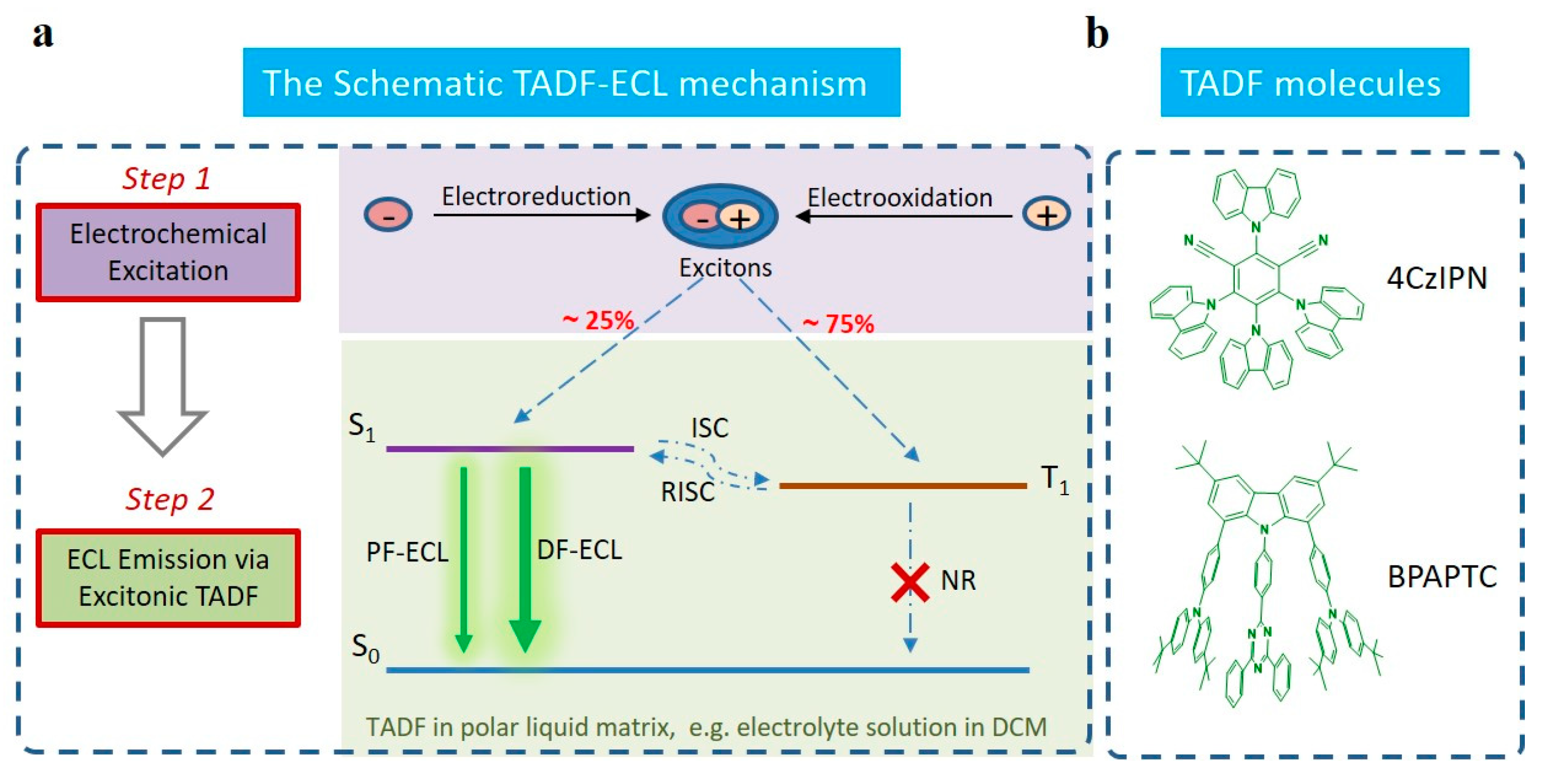
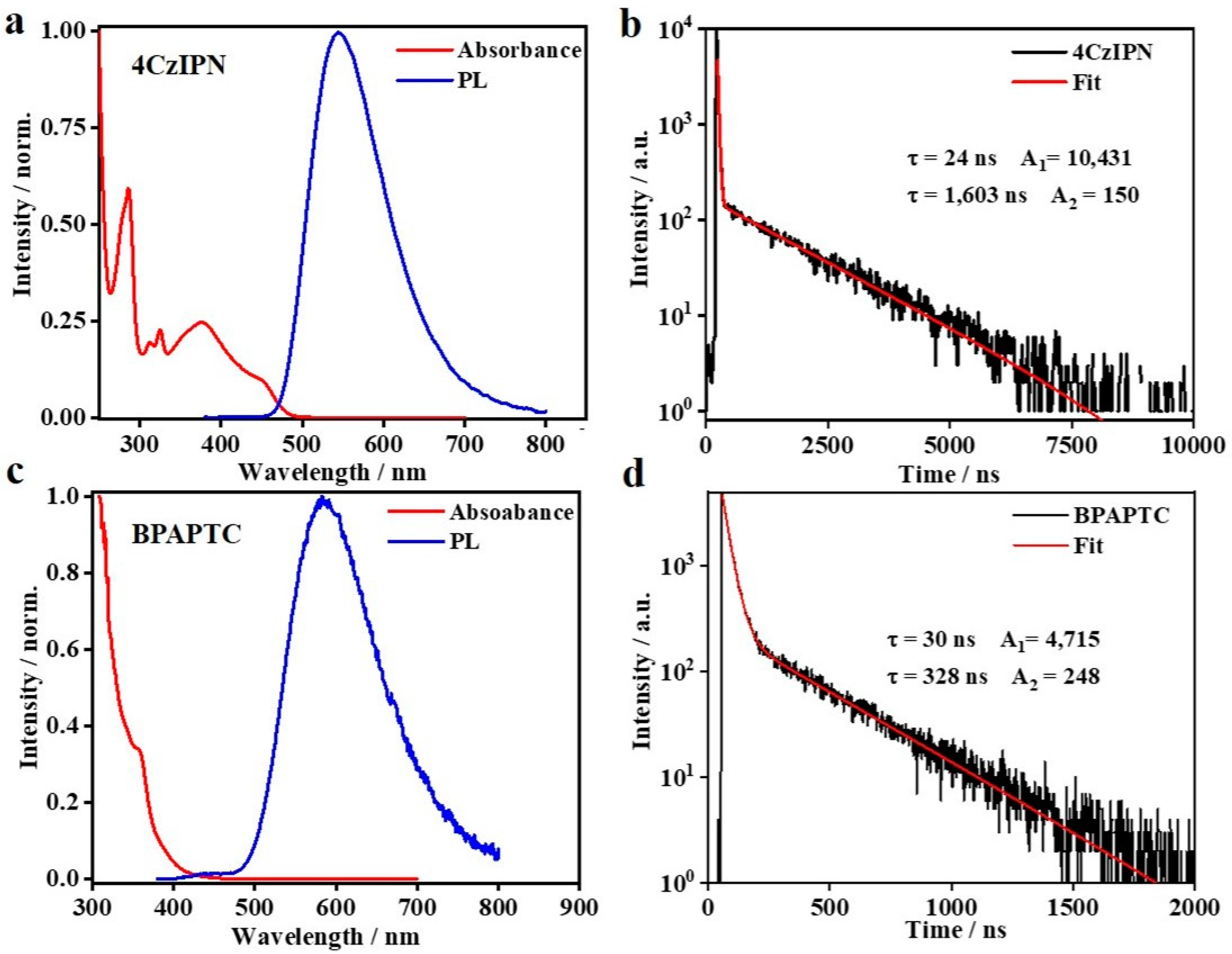
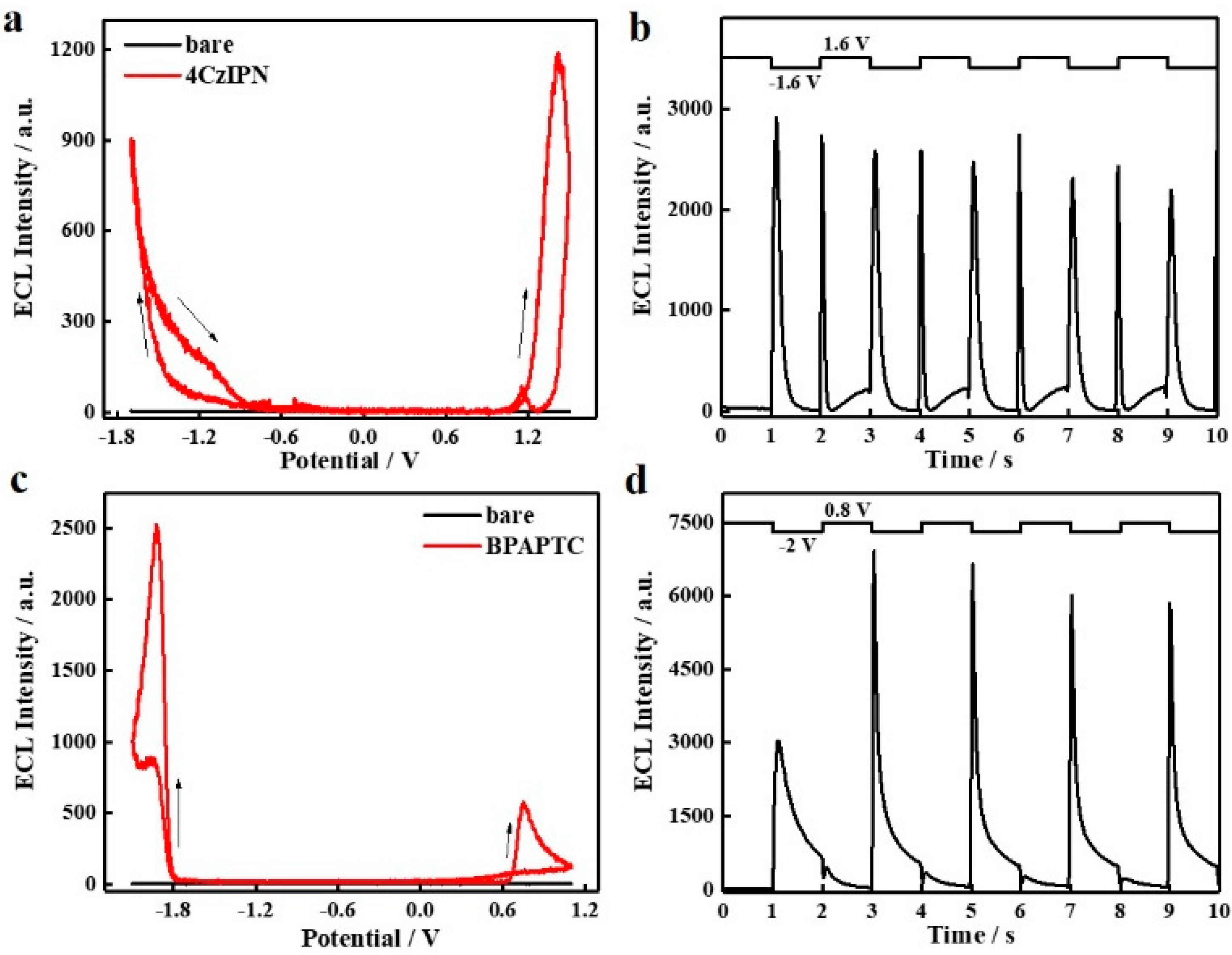

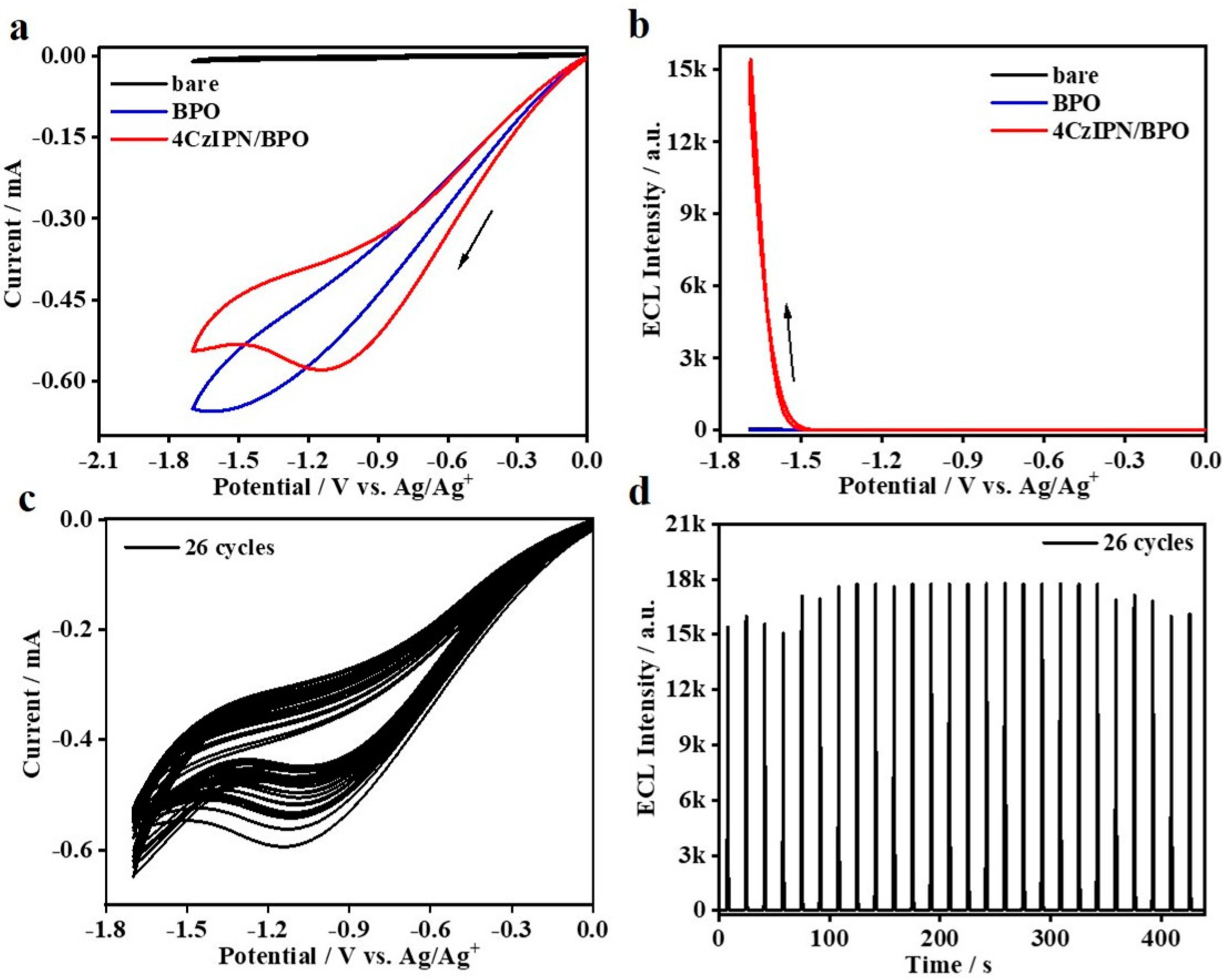
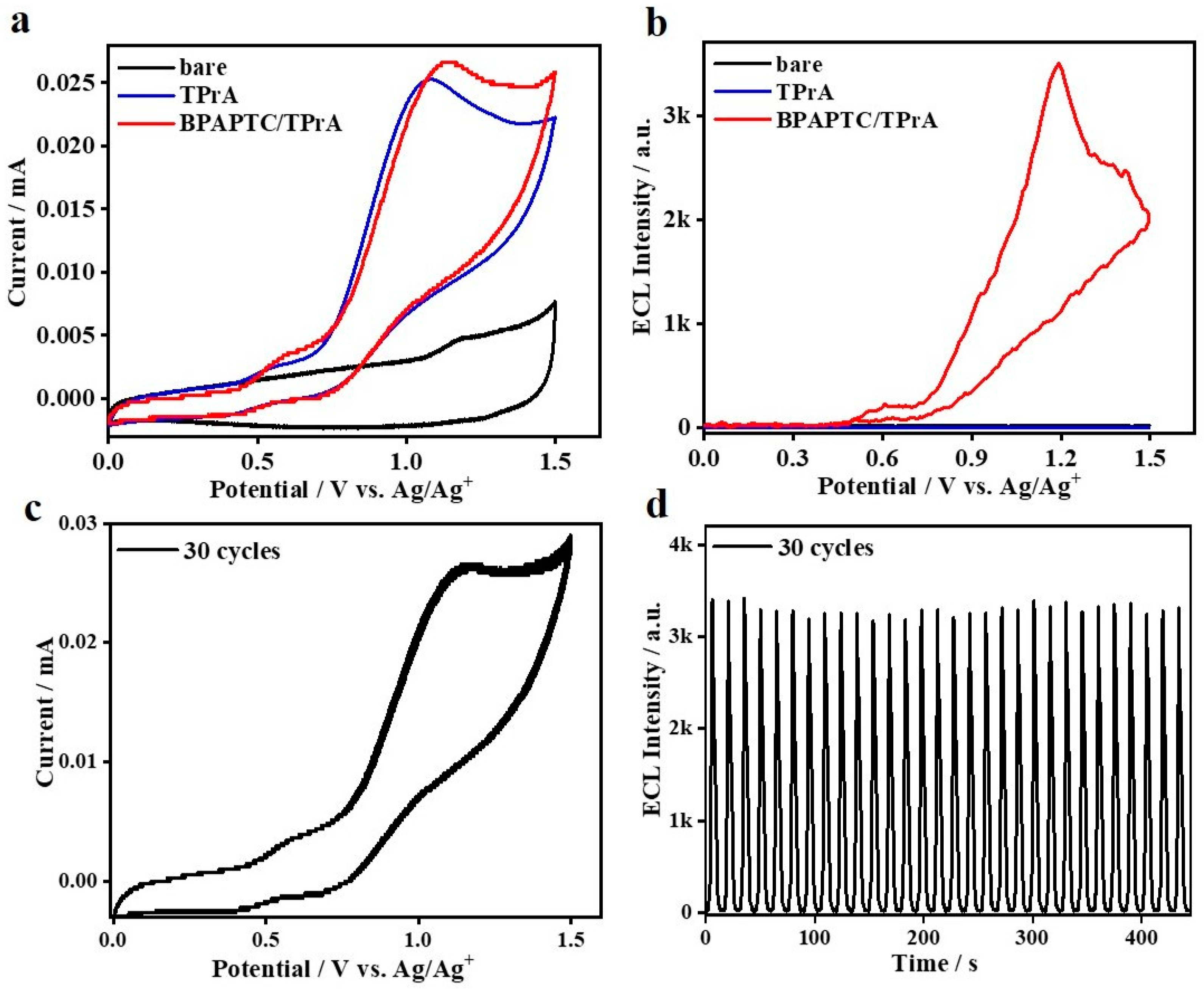
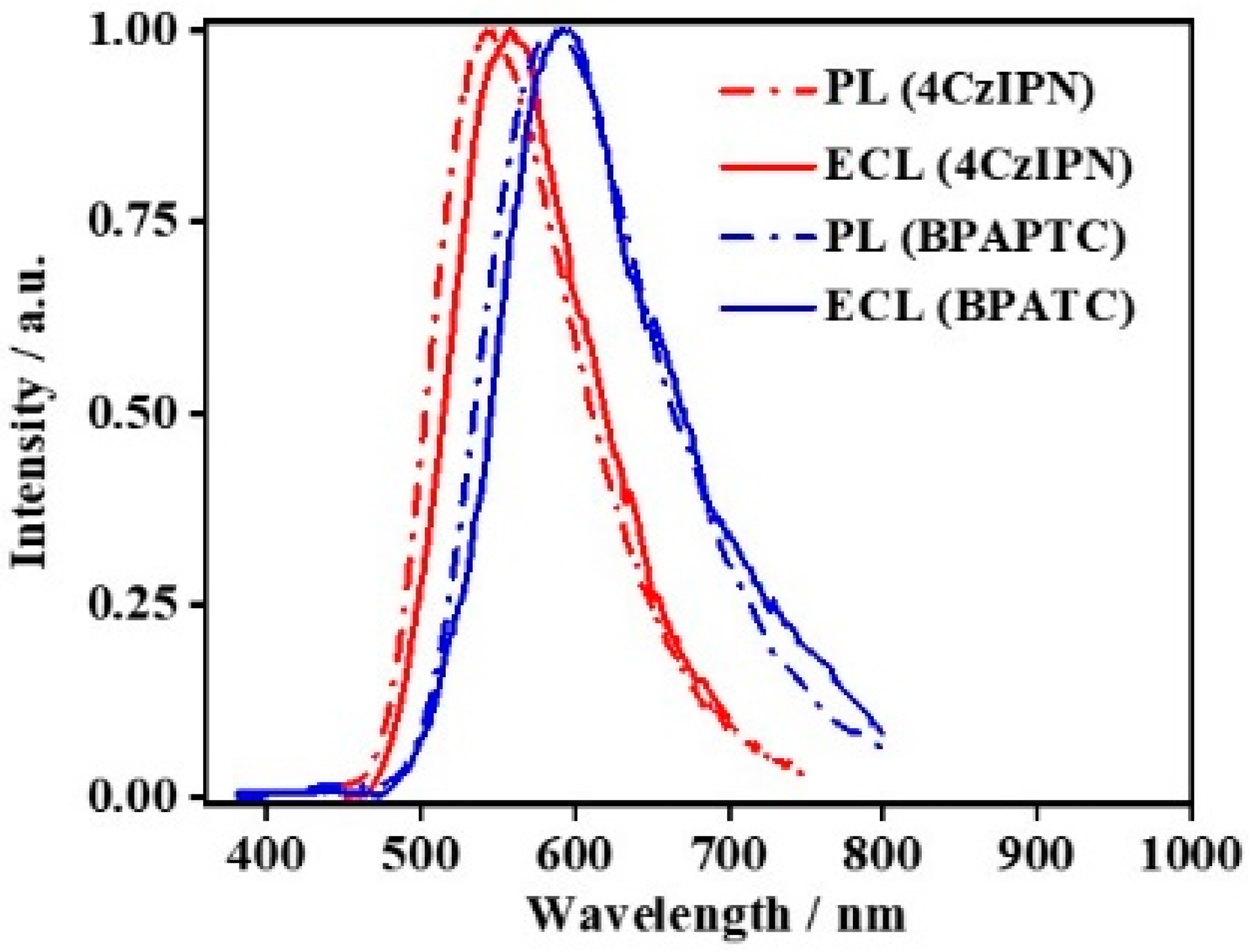

Publisher’s Note: MDPI stays neutral with regard to jurisdictional claims in published maps and institutional affiliations. |
© 2022 by the authors. Licensee MDPI, Basel, Switzerland. This article is an open access article distributed under the terms and conditions of the Creative Commons Attribution (CC BY) license (https://creativecommons.org/licenses/by/4.0/).
Share and Cite
Huang, P.; Zou, X.; Xu, Z.; Lan, Y.; Chen, L.; Zhang, B.; Niu, L. Studies on Annihilation and Coreactant Electrochemiluminescence of Thermally Activated Delayed Fluorescent Molecules in Organic Medium. Molecules 2022, 27, 7457. https://doi.org/10.3390/molecules27217457
Huang P, Zou X, Xu Z, Lan Y, Chen L, Zhang B, Niu L. Studies on Annihilation and Coreactant Electrochemiluminescence of Thermally Activated Delayed Fluorescent Molecules in Organic Medium. Molecules. 2022; 27(21):7457. https://doi.org/10.3390/molecules27217457
Chicago/Turabian StyleHuang, Ping, Xingzi Zou, Zhiyun Xu, Yanting Lan, Lijuan Chen, Baohua Zhang, and Li Niu. 2022. "Studies on Annihilation and Coreactant Electrochemiluminescence of Thermally Activated Delayed Fluorescent Molecules in Organic Medium" Molecules 27, no. 21: 7457. https://doi.org/10.3390/molecules27217457
APA StyleHuang, P., Zou, X., Xu, Z., Lan, Y., Chen, L., Zhang, B., & Niu, L. (2022). Studies on Annihilation and Coreactant Electrochemiluminescence of Thermally Activated Delayed Fluorescent Molecules in Organic Medium. Molecules, 27(21), 7457. https://doi.org/10.3390/molecules27217457







